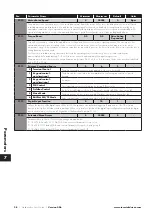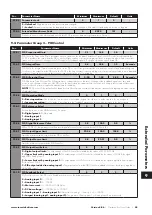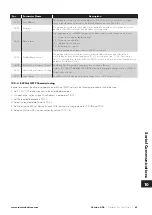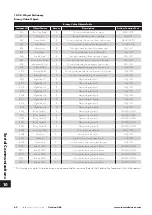
52
| Optidrive Eco User Guide |
Version 3.06
www.invertekdrives.com
Par.
Name
Minimum
Maximum
Default
Units
P8-14
Pump Staging Function Select
0
5
0
-
Parameter enables the pump staging (cascade) function on the drive.
0 : Disabled
1 : Single VFD with DOL Cascade (max 4 DOL pumps)
2 : Multiple Drive Cascade (Optiflow) Master Drive.
(Only valid when drive set to Optibus master address, P5-01 = 1).
3 : Multiple Drive Cascade with Jockey Pump (Optiflow).
Master Drive (Only valid when drive set to Optibus master
address, P5-01 = 1) In this instance, the Master drive (with address P5-01 =1) will remain active and will not be switched off to support
the pump rotation ordinarily used for the purpose of sharing operating hours across all pumps.
4 : Multiple Drive Cascade Mode 2 (Optiflow) Master Drive.
(Only valid when drive set to Optibus master address, P5-01
= 1) This mode is similar to mode 2 but the settling time works differently which can prevent multiple motors starting simultaneously when
waking up from PID Standby mode.
5 : Multiple Drive Cascade with Jockey Pump Mode 2 (Optiflow) Master Drive.
(Only valid when drive set to Optibus
master address, P5- 01 = 1) This mode is the same as mode 3 except that when an assist pump starts, the lead pump (jockey pump) will
stop. When the assist pump goes into standby mode, the lead pump (jockey pump) will start again.
P8-15
Number of Assist Pumps
1
4
1
-
Parameter valid when P8-14 is set to 1 or 2 to enable Pump Staging Function. P8-15 set the number of assist pumps (P8-14 = 1) or
network slave drives (P8-14 = 2) that are available in the Pump Staging application. Setting the value to 0 disables Pump Staging.
P8-16
Pump Duty Changeover Time
0
1000
0
Hours
In order to balance run time (duty) on each pump in the Pump staging application and to ensure periodic operation of each pump P8-16
can be set with a time limit for pump switch over. When set to a value other than 0 (disabled) the operation of each staging pump will be
cycled to ensure the difference in duty between each pump does not exceed the time set in P8-16.
P8-17
Assist Pump Start Speed
P8-18
P1-01
49.0
Hz / Rpm
This parameter defines the speed at which an “Assist” Pump is started when using the Pump Cascade or Optiflow feature. When the drive
output increases beyond this threshold the next Staging pump is switch on. The Pump staging settle time must then expire before additional
staging pumps can be brought on or off line. Priority for Staging pump switch on is always given to the pump with lowest run time
accumulated.
P8-18
Assist Pump Stop Speed
0
P8-17
30.0
Hz / Rpm
This parameter defines the speed at which an “Assist” Pump is stopped when using the Pump Cascade or Optiflow feature. When the drive
output decreases below this threshold one of the Staging pumps currently operating is switch off. The Pump staging settle time must then
expire before additional staging pumps can be brought on or off line. Priority for Staging pump switch off is always given to the pump with
highest run time accumulated.
P8-19
Pump Settling Time
2
600
60
Seconds
Parameter sets a time delay for pump staging whereby, following switch in or switch out of a staging pump, further pumps are not
permitted to be switched in or out until this time period has elapsed. This parameter should be set to allow adequate settle time between
staging pump transitions.
P8-20 Pump Master Clock Reset
0
1
0
-
Master drive in pump staging monitors and maintains duty run times for all available staging pumps. All clocks are available to view in
P0-20. P8-20 provides the master reset to all run time clocks used for Pump Staging Function (all clocks set to 0).
9.7. Fire Mode
The Fire Mode function is designed to ensure continuous operation of the drive in emergency conditions until the drive is no longer
capable of sustaining operation.
The Fire Mode input may be Normally Open (Close to Activate Fire Mode) or Normally Closed (Open to Activate Fire Mode)
according to the setting of P8-09. This input may be linked to a fire control system to allow maintained operation in emergency
conditions, e.g. to clear smoke or maintain air quality within the building. The fire mode function is enabled when P1-13 = 4, 8 or 13
with Digital Input 2 assigned to activate fire mode or can be user defined by the setting of P9-32 when P1-13 = 0.
Fire Mode disables the following protection features in the drive: O-t (Heat-sink Over-Temperature), U-t (Drive Under Temperature),
Th-FLt (Faulty Thermistor on Heat-sink), E-trip (External Trip), 4-20 F (4-20mA fault), Ph-Ib (Phase Imbalance), P-Loss (Input Phase Loss
Trip), SC-trp (Communications Loss Trip), I.t-trp (Accumulated overload Trip). The following faults will result in a drive trip, auto reset
and restart: O-Volt (Over Voltage on DC Bus), U-Volt (Under Voltage on DC Bus), h O-I (Fast Over-current Trip), O-I (Instantaneous
over current on drive output), Out-F (Drive output fault, Output stage trip).
When Fire Mode is activated, the drive will enter Fire Mode but will run from the existing control source selected – it will require the
run signal and relevant speed reference.
If Fire Mode speed is set (<>0) in P8-10, when fire mode is activated, the drive will enter Fire Mode and run at the speed set in P8-10
and will ignore all other terminals with the exception of the STO.
9
Extended P
arameters
















































